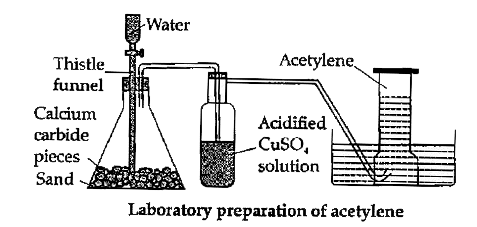Cus is not precipitated by passing through copper sulphate solution containing KCN. Give reason
To understand why copper(I) sulfide (CuS) is not precipitated when passing hydrogen sulfide (H₂S) through a copper sulfate (CuSO₄) solution containing potassium cyanide (KCN), we can break down the explanation into several steps:
1. Understanding the Components:
- We start with a solution of copper sulfate (CuSO₄) and potassium cyanide (KCN). When KCN is added to the CuSO₄ solution, it forms a complex ion.
2. Formation of the Complex Ion:
- The reaction between CuSO₄ and KCN leads to the formation of potassium tetra-cyanocuprate(II), represented as K₂(Cu(CN)₄). This complex ion is stable in solution.
3. Oxidation State of Copper:
- In the complex ion K₂(Cu(CN)₄), we need to determine the oxidation state of copper (Cu). The cyanide ion (CN⁻) has a charge of -1, and since there are four cyanide ions, their total contribution to the charge is -4.
- To balance this with the overall charge of the complex ion, the oxidation state of copper (let's denote it as X) can be calculated as follows:
X+(−4)=−2⇒X=+2
- Therefore, the oxidation state of copper in this complex is +2.
4. Behavior of H₂S in the Solution:
- When H₂S is passed through the solution, it dissociates to form H⁺ and S²⁻ ions. The sulfide ion (S²⁻) can potentially react with Cu²⁺ ions to form copper(I) sulfide (CuS), which is a precipitate.
- However, in the presence of KCN, the Cu²⁺ ions do not exist freely in the solution because they are part of the stable complex K₂(Cu(CN)₄).
5. Conclusion:
- Since the Cu²⁺ ions are not available in the solution due to complexation with cyanide ions, H₂S cannot precipitate CuS. Therefore, no precipitation occurs when H₂S is passed through the copper sulfate solution containing KCN.
Final Answer:
Copper(I) sulfide (CuS) is not precipitated when passing hydrogen sulfide (H₂S) through a copper sulfate solution containing potassium cyanide (KCN) because the copper ions are complexed with cyanide ions, preventing the formation of free Cu²⁺ ions that would react with sulfide ions to form the precipitate.
---
- We start with a solution of copper sulfate (CuSO₄) and potassium cyanide (KCN). When KCN is added to the CuSO₄ solution, it forms a complex ion.
- The reaction between CuSO₄ and KCN leads to the formation of potassium tetra-cyanocuprate(II), represented as K₂(Cu(CN)₄). This complex ion is stable in solution.
- In the complex ion K₂(Cu(CN)₄), we need to determine the oxidation state of copper (Cu). The cyanide ion (CN⁻) has a charge of -1, and since there are four cyanide ions, their total contribution to the charge is -4.
- To balance this with the overall charge of the complex ion, the oxidation state of copper (let's denote it as X) can be calculated as follows:
X+(−4)=−2⇒X=+2
- Therefore, the oxidation state of copper in this complex is +2.
- When H₂S is passed through the solution, it dissociates to form H⁺ and S²⁻ ions. The sulfide ion (S²⁻) can potentially react with Cu²⁺ ions to form copper(I) sulfide (CuS), which is a precipitate.
- However, in the presence of KCN, the Cu²⁺ ions do not exist freely in the solution because they are part of the stable complex K₂(Cu(CN)₄).
- Since the Cu²⁺ ions are not available in the solution due to complexation with cyanide ions, H₂S cannot precipitate CuS. Therefore, no precipitation occurs when H₂S is passed through the copper sulfate solution containing KCN.
Copper(I) sulfide (CuS) is not precipitated when passing hydrogen sulfide (H₂S) through a copper sulfate solution containing potassium cyanide (KCN) because the copper ions are complexed with cyanide ions, preventing the formation of free Cu²⁺ ions that would react with sulfide ions to form the precipitate.
Similar Questions
Knowledge Check
An electric current is passed through silver nitrate solution using silver electrodes. 15.28 g of silver was found to be deposited on catode. What will be the weight of copper deposited on cathode if same amount of electricity is passed through copper sulphate solution using copper electrodes?
A4.49 gB6.4 gC12.8 gD3.2 g
An orange red precipitate obtained by passing H2S through an acidified solution of an inorganic salt indicates the presence of
View SolutionWhy is CaSO4 not precipitated on adding ammonium sulphate to a solution containing Ca2+ and Sr2+ ions?
View SolutionWhat do you observe when
HS gas is passed through copper sulphate solution.
View SolutionWhy are the group IV cations not precipitated as sulphides on passing H2S gas through group II solution?
View Solution
Give the function of acidified copper sulphate solution.
View SolutionExplain giving reasons why (Give equations in support of your answer) :∗∗
Cu is precipitated as Cus while Zn is not precipitated when H2S is passed through an acidic solution of Cu(NO3)2andZn(NO3)2 respectively.
View Solution2.5 amperes of current is passed through copper sulphate solution for 30 minutes. Calculate the number of copper atoms deposited at the cathode (Cu = 63.54).
View Solution
